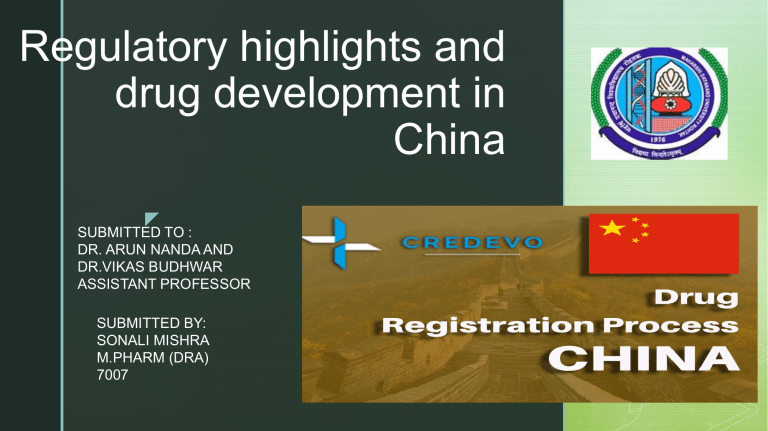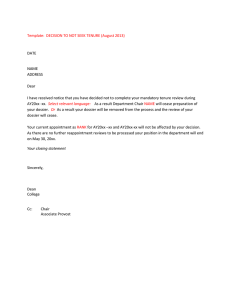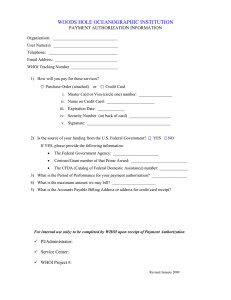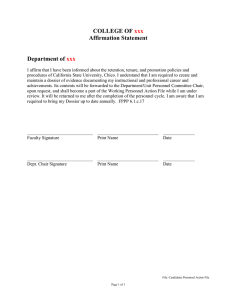
Regulatory highlights and drug development in China z SUBMITTED TO : DR. ARUN NANDA AND DR.VIKAS BUDHWAR ASSISTANT PROFESSOR SUBMITTED BY: SONALI MISHRA M.PHARM (DRA) 7007 z CONTENTS INTRODUCTION CHINESE REGULATORY AUTHORITY HIGHLIGHTS OF CHINA’S NEW PROVISION & OPPURTUNITIES FOR DRUG REGISTRATION DRUG REGISTRATION IN CHINA CLINICAL TRIAL APPLICATION CHINA IMPORT DRUGS LICENSE (CFDA) CERTIFICATE z REQUIREMENTS FOR APPROVAL OF IMPORTED DRUGS IN CHINA REVIEW PROCESS FOR DRUG MARKETING AUTHORIZATIONS DRUG REGISTRATION CERTIFICATE VALIDITY AND REREGISTRATION ACCELERATED APPROVALS FOR DRUG REGISTRATION z INTRODUCTION CHINA - Growing and Distinctive Pharmaceutical market China is one of the largest pharmaceutical markets in the world, but the status is arguably due to the size of its population, as the market is not yet mature. The combined forces of economic and demographic development, government stimulus, and enhanced health awareness among the public, market consolidation, and improving R&D capability may help the country to grow into a more sophisticated market within the next decade. China’s pharmaceutical drug market is constantly growing and is the z second-largest pharmaceutical industry in the world, after the United States. It is estimated to reach $161.8 billion by 2023, with an average growth rate of 5% in the coming years, taking a 30% share of the global market. The acceleration of new drug access, changing regulatory landscape of individual categories, the rapidly aging Chinese society, and subsequently increasing medical needs provide a range of opportunities for the pharmaceutical market. After 13 years, the Chinese regulatory has made several changes in the rules and guidelines for registering drugs. These changes made are to reduce the complexity and match up with the other global regulators z Chinese Regulatory Authority The Regulatory Authority of People Republic of China is State Food and Drug Administration (CFDA)former it is termed as (SFDA). In March 2013, the regulatory body was re branded and restructured as the China Food and Drug Administration, elevating it to a ministerial-level agency. The CFDA replaced a large group of overlapping regulators with an entity similar to the Food and Drug Administration of the United States, streamlining regulation processes for food and drug safety. The China Food and Drug Administration is directly under the State Council of the People's Republic of China, which is in charge of comprehensive supervision on the safety management of food, health food and cosmetics and is the competent authority of drug regulation in mainland China. z SFDA The State Food and Drug Administration (SFDA) (Chinese: 国家食 品药品监督管理局) is founded on the basis of the State Drug Administration. The State Food and Drug Administration is directly under the State Council of the People’s Republic of China, which is in charge of comprehensive supervision on the safety management of food, health food and cosmetics and is the competent authority of drug regulation in mainland China. z cFDA to NMPA The China Food & Drug Administration (CFDA), now called the National Medical Products Administration (NMPA), is responsible for medical devices, drugs, and healthcare services. The organization is headquartered in Beijing, with offices in each province. The Center for Medical Device Evaluation (CMDE) is responsible for conducting the dossier review during the medical device registration process. The General Administration of Quality Supervision, Inspection, and Quarantine (AQSIQ) conducts mandatory safety registration, certification, and inspection for certain devices. z The National Medical Products Administration (NMPA) is the main regulatory authority responsible for drug registration management, formulating drug registration specifications, and organizing drug registration review and approval. NMPA’s Drug Evaluation Center (CDE) is responsible for the review of drug clinical trial applications, drug marketing authorization applications, supplementary applications, and drug re-registration applications for overseas manufactured drugs. z Highlights of China’s new provisions and opportunities for drug registration The 60 days of timeframe for CTA approval following the global regulations. Clear timelines for review and approval for different types of drug registration applications. Streamline processes between drug registration and manufacturing authorization to ensure GMP. z Improvement of communications between the applicant and Center for Drug Evaluation (CDE) for effective CTA process. The introduction of parallel risk-based site inspections and lab tests registration conduction with the technical review. Breakthrough and the conditional approval during the clinical trial stage, and the priority review during marketing approval expediting drug registration and satisfying unmet medical needs in China. z Drug registration in China The Marketing Authorization Holder (MAH) can submit applications for drug clinical trials, drug marketing authorization, re-registration, and supplementary applications. Along with these duties, MAH can also handle various other duties. z Medicinal product registration categories in China The requirements to develop and register a medicinal product in China depend on further classification: Chemical medicine Biological products Traditional chinese medicine. Each type is then classified into three registration categories, which determine the materials that the applicant must provide as part of its registration application example clinical trial application, marketing authorization application, etc. z For chemical medicines, registration categories are as follows Innovative drugs Improved new drugs Generics z For biologics, registration categories are as follows Innovative biological products Improved new biological products Marketed biological products (including biosimilars) z The corresponding application materials requirements are based on the product characteristics, degree of innovation, and review management needs of the registered medicines. The drug category in which an applicant chooses to register decides the clinical trial application review and approval process. NMPA manages the clinical trial application. z Steps involved in Registration of Imported Drugs in China Generic product registration can be carried out by an agent in China. Overseas manufacturers of pharmaceutical products without legal representation in China are thus required to apply for product registration through agent services. An application is submitted to the CFDA, there by the review process is done by CDE (Center for Drug Evaluation) z General requirements for application dossiers The first page of the dossiers shall be a directory for application items, which shall be arranged in order as per the “Provisions for Drug Registration” (SFDA Order No. 28). Each dossier shall indicate on its cover: the name of the drug and application item, document item number, and the name, phone number and address of contact person and the applicant. All documents in the dossier shall be printed or copied in A4 size paper. The content shall be complete, standardized, clear, without alteration, and the data must be real and reliable. z The documents shall be put in portfolio envelope(s), on which the application classification, registration category, drug name, the envelope number of set X, the total number of envelopes in the set, original or copy, the contact person, phone number and the name of registration application agent shall be indicated. Two sets of complete application dossiers (at least one set is in the original) and one set of review documents in hard copy shall be submitted for registration application. Four application forms (1 in the original and 3 in hard copy) shall be separately put into each set of dossier (the original application form and a hard copy shall be put in the set of the dossier in the original). z "Import Drug Registration Application Form": the drug registration application form submission program could be downloaded from CFDA website (www.cfda.gov.cn); the application form shall be filled in as required, printed and saved, and shall be signed by the overseas applicant, and signed & sealed by its domestic agent. When mailing or submitting the application dossiers, the electronic version of the application form shall be sent to the following e-mail address dedicated for drug registration: slzx@cfda.gov.cn. z The data checking code on the electronic and paper application form should be identical. Foreign language materials shall be translated into Chinese. z CLINICAL TRIAL APPLICATION If your products nned not to be conducted clinical trials and Application dossier are appropriate ,you shall obtain IDL within 9-12 months after submission. If clinical trials must be conducted ,the general procedure is : Step 1 - Submitting an application and if application dossier are appropriate ,you shall obtain Clinical Trials Permission (CTP ) within about 10-12 months after submission . z z Step 2 - Conducting the clinical trials ,if just carry out bioequivalence trials ,it might be take 3 to 6 months ,but other clinical trials might be take more than 1-1.5 yr to complete. z z Step 3 - Submitting the Application Dossier (include the reports of clinical trials ) and if the applicatiom dossier are appropriate ,you shall obtain IDL within about 12 -18 months after submission. z CHINA IMPORT DRUGS LICENSE (CFDA) CERTIFICATE z z Imported drug registration process (after clinical study) z The first step in this process is to submit an application to the CFDA for a Clinical Trial Application (CTA). The CFDA will conduct a preliminary review of the submission package and then transfer the dossier to the Center for Drug Evaluation (CDE). Reviewers with background in pharmaceuticals, pharmacology and clinical study will run a technical review, while local sample testing will also be conducted in parallel. z Few CTAs would pass through the CDE review in one single round. However, most applications will receive supplement notice(s) in writing to request additional information for further assessment. In such case, CDE will allow a 4-month period for applicant to gather and submit additional requested information to CDE. This entire CTA step usually takes at least 125 working days. z The second step in drug registration is Production Application (or Imported Drug License Application), which involves submitting a clinical report and other relevant dossiers to obtain an imported drug license. The process itself is basically the same as the CTA step. This second step will take approximately 145 days. z REQUIREMENTS FOR APPROVAL OF IMPORTED DRUGS IN CHINA z The review process for drug marketing authorization After completing the pre-clinical studies and clinical studies supporting the drug registration, the applicant should submit the drug marketing authorization application according to the requirements. After the formal examination of the application materials, acceptance will be given if they meet the requirements. The Drug Evaluation Center (CDE) organizes pharmacy, medical, and other technical personnel to review the accepted drug marketing authorization applications. After the conclusion of the comprehensive review, issues a registration certificate for drugs. If the conclusion of the comprehensive review is not passed, the application is disapproved z z Drug registration certificate validity and re-registration The validity period of the drug registration certificate of drug Marketing Authorization Holder is five years. During the validity period, the MAH must take responsibility of the safety, effectiveness and quality controllability of the listed drugs and apply for drug re-registration six months prior the expiration of the validity period. z Accelerated approvals for drugs registration According to the regulation, NMPA initiated new drug review process and has divided the approval process into the following four categories Breakthrough approval Priority review Conditional approval Special approval The applicant needs to know for which category of drugs do these review processes apply at which stage of drug development may apply. z REFERENCES https://www.sfdachina.com/ https://globalforum.diaglobal.org/issue/may-2020/revised-drug- registration-regulation-brings-new-challenges-and-opportunitiesto-new-drug-clinical-trials-in-china/ https://clinregs.niaid.nih.gov/country/china#timeline_of_review http://english.nmpa.gov.cn/2019-07/25/c_390615.htm https://credevo.com/articles/2021/02/25/china-drug-registration- process/ z https://www.researchgate.net/publication/303278910_Regulatory_requirements_ and_registration_process_of_Generic_Drugs_in_China https://pharmaboardroom.com/legal-articles/amended-drug-registrationregulation-aims-to-strengthen-and-streamline-regulation-of-new-drugs/ http://www.sfdachina.com/infosort/11_1.htm https://www.pacificbridgemedical.com/regulatoryservices/pharmaceutical/product-registration/china/ z


